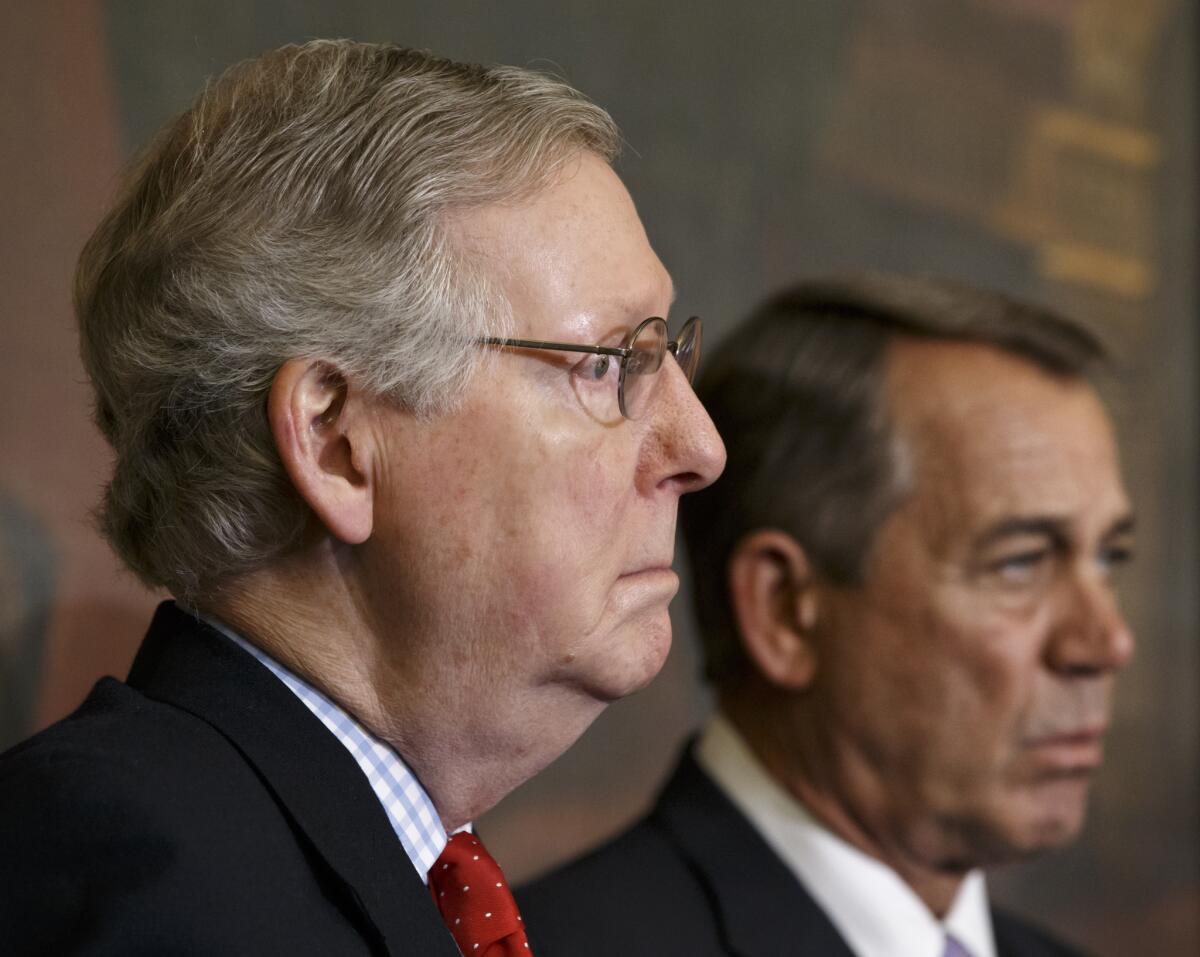Republicans struggle to present unified front over 2016 budget

- Share via
Reporting from Washington — Congressional Republicans are poised Tuesday to release their proposed 2016 budget, an annual blueprint that usually serves as a political rallying cry for smaller government.
This year, however, with Republican majorities in both chambers of Congress, the process promises to ignite a fresh round of GOP infighting as the party faces the limits of its budget-slashing aspirations.
The party’s ambitious goals to rein in the nation’s $18-trillion debt will require deeply painful reductions in government spending that GOP defense hawks refuse to stomach, particularly when it comes to the Pentagon.
But faced with pressure from fiscal conservatives for a tough approach that cuts across all aspects of the federal government, Republican leaders will be hard-pressed to produce a document that can unify its ranks. Whether House Speaker John A. Boehner (R-Ohio) and Senate Majority Leader Mitch McConnell (R-Ky.) will be able to usher a budget to passage remains uncertain.
The party’s budget problems are the latest challenge for the Republican-led Congress, which swept into power promising not only to cut spending but also to use the budget process to attack President Obama’s top priorities, including the Affordable Care Act.
Those ambitions may need to be scaled back as the party struggles to find common ground on the fiscal blueprint itself.
On Monday, Sen. John McCain (R-Ariz.) announced that he was working with a group of like-minded lawmakers to preserve Pentagon spending, setting up a potential showdown.
“Providing for our national defense is the most fundamental test of our ability to govern,” McCain said. “Republicans cannot afford to fail this test.”
Even before the GOP took control of Congress this year, rolling back what many lawmakers have characterized as out-of-control federal spending had been a hallmark of the party’s platform.
Republicans vowed to balance the budget within 10 years — a goal set by the party’s leading budget guru, Rep. Paul D. Ryan (R-Wis.), the onetime vice presidential candidate and former chairman of the House Budget Committee.
“It’s a plan to get Washington’s fiscal house in order,” said Rep. Tom Price (R-Ga.), the committee’s new chairman, in a video preview of the budget plan before Tuesday’s scheduled release.
But reaching that milestone has proved difficult — especially while adhering to the GOP’s no-new-taxes pledge.
Democrats have refused to go along with Republican proposals to cut domestic accounts and substantially overhaul Medicare and Medicaid safety net programs. And even some Senate Republicans appear uneasy with the specific cuts to the entitlement programs proposed by the House.
Sen. Bernie Sanders (I-Vt.), who heads the Senate Budget Committee for Democrats, has warned against a budget that represents “the Robin Hood principle in reverse.”
“We must not take from the poor to give to the rich,” Sanders said. “We must not cut programs that the elderly, the children, the sick, the poor and working families desperately depend on, in order to give more tax breaks to large, profitable corporations.”
At issue are the so-called sequester cuts that both parties reluctantly agreed to as part of the 2011 budget showdown.
Most of those cuts had been postponed because lawmakers decided they were too politically painful.
But now those cuts are set to roar back in full with the start of the new fiscal year Oct. 1, setting up a budget showdown not only between Democrats and Republicans but also between the GOP’s defense and deficit hawks.
Obama proposed doing away with $74 billion of sequester cuts in his own 2016 budget, which proposed new taxes on wealthier households and corporations as a way to pay for reversing reductions planned for the Pentagon and other programs.
Improvements in the economic outlook, including the smallest federal deficits since the start of the Great Recession, gave the White House the political momentum to rebuff the GOP’s push for more austerity.
Republicans loath to allow the president’s budget to provide greater Pentagon funding than their own are desperately seeking an alternative.
In the House, Republicans will probably propose increasing funds of overseas contingency operations as a way to boost Pentagon spending to at least the president’s proposed level.
One option for Senate Republicans would be to set up a two-part strategy in which Congress preserves the sequester cuts but then establishes a Deficit Neutral Reserve Fund that could be used to offset the Pentagon cuts with budget reductions elsewhere, likely in domestic programs.
“It leaves open a negotiation for a few months down the road,” Sen. Bob Corker (R-Tenn.) said as he emerged from a closed budget briefing with Republican senators last week. “The military hawks are becoming comfortable” with it.
But the most hardened fiscal conservatives may view that strategy as little more than a punt that opens the door to more spending — and one they will not support.
“Fiscal discipline is needed across the federal government and that includes defense spending,” wrote a coalition of anti-tax groups and deficit hawks in a letter to GOP leadership, insisting that their budget “keeps promises made to taxpayers.”
As of Monday evening, many Republicans had not yet seen their party’s proposal. More pragmatic members were still considering the options. “It’s still a work in progress,” said Sen. Susan Collins (R-Maine).
lisa.mascaro@latimes.com
More to Read
Get the L.A. Times Politics newsletter
Deeply reported insights into legislation, politics and policy from Sacramento, Washington and beyond. In your inbox twice per week.
You may occasionally receive promotional content from the Los Angeles Times.











